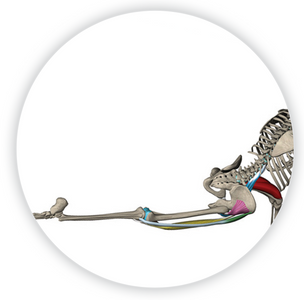Iliotibial Band Syndrome (IT Band Syndrome) is a common overuse injury, especially among runners and cyclists. It occurs when the iliotibial band, a thick band of fibrous connective tissue/ fascia that runs along the outside of the thigh from the hip to the knee, becomes inflamed and irritated.
The friction between the IT band and the underlying structures, such as the lateral knee, can cause pain and discomfort.
The iliotibial (IT) band itself is not considered elastic, and its stretching capacity is limited. Its main function is to provide stability to the hip and knee during movement. Great strength and stiffness is required for this task. Stretching the IT band directly therefore is challenging and might not yield significant lengthening due to its structural composition. However, when people refer to “stretching the IT band,” they often mean stretching the muscles and tissues surrounding the IT band, which can indirectly affect the tension and function of the IT band.
The IT band is closely connected to several muscles, including the gluteus maximus, tensor fasciae latae (TFL), and the lateral quadriceps. When people perform IT band stretches, they often target these associated muscles to help reduce tightness and tension in the entire hip and thigh region. This practice is valuable for managing IT Band Syndrome and promoting overall hip and thigh flexibility.
The Anatomy
The iliotibial (IT) band is a thick, fibrous band of connective tissue that runs along the outside of the thigh. Here’s an overview of the anatomy of the IT band:
Origin
The IT band originates from the following primary structures.
The anteriorlateral portion of the iliac crest
It consists of superficial and deep layers which converge to form a single thick band after they travel distal to the TFL muscle.

The tensor fasciae latae (TFL) muscle
The TFL is a small muscle located at the front of the hip. It is one of the hip flexor muscles and plays a role in flexing, abducting, and internally rotating the hip joint.
The gluteus maximus muscle
The gluteus maximus is the largest muscle in the buttocks and is involved in hip extension, external rotation, and abduction.

Course
The IT band travels along the lateral (outside) aspect of the thigh. As it descends, it runs over the lateral femoral epicondyle, a bony prominence on the outside of the knee joint.
Insertion
The IT band inserts into two main locations. The lateral condyle of the tibia: The IT band connects to the tubercle of the IT tract which is located on the lateral (outer) aspect of the tibia bone just below the knee joint.

The lateral patellar retinaculum
The IT band also blends with the lateral retinaculum, a fibrous structure that helps stabilize the patella (kneecap).

Function
The primary function of the IT band is to provide stability to the hip and knee joints during various movements, especially during walking, running, and cycling. It works in conjunction with the gluteus maximus and TFL muscles to control and stabilize the motion of the hip and knee.
Stretching
Stretching the IT band can be helpful in managing IT Band Syndrome in the following ways:
Alleviating Tension: Stretching the IT band can help reduce tension along its length. When the IT band is excessively tight, it may pull on its attachments, leading to inflammation and pain. Stretching can help to ease this tension.
Promoting Flexibility: Regular stretching can increase the flexibility of the IT band (slightly) and surrounding muscles, such as the glutes and hip flexors. Improved flexibility can reduce the strain on the IT band during physical activities, potentially decreasing the risk of irritation and injury.
Addressing Muscle Imbalances: IT Band Syndrome can be linked to muscle imbalances in the hip and thigh region. By stretching the IT band and associated muscles, you can work on restoring balance and symmetry, which may alleviate stress on the IT band.
Preventing Overuse: Runners and athletes who engage in repetitive movements are more prone to IT Band Syndrome. Stretching before and after exercise can help warm up the IT band and surrounding muscles, reducing the risk of injury from overuse.
Generally, it is necessary to explore several stretches to target the region effectively. First, start with the gluteal muscles. Three stretches are recommended for the Gluteal region.
A. The posterior gluteal region
B. The lateral gluteal region
28. The standing abductors stretch
An alternative to this stretch is a kneeling version. Please try both, because although they target the same region, they often feel different to perform.
29. The Kneeling Glutes
Stretch 19. The TFL variation
Second, stretch the TFL itself. This small muscle is tricky to isolate and identify, so careful attention and exploration are required.
27. The Lunge Pose
If you don’t have any StretchFit equipment, the stretch below, in particular the variation, may help to isolate the TFL.
HOW TO STRETCH: Photo A
Kneel as pictured, keeping arms inside of
front foot
Keep spine straight
Take rear leg back as far as possible
Keep front knee open at about 100° angle
Sink hips towards floor
HOW TO CONTRACT:
Photo A- Press both feet down into floor (do not move)
HOW TO RESTRETCH:
Photo B- Lean hips closer to floor, OR for more effect
lift rear knee from floor (do not allow hips to lift)
PARTNER ASSIST: Photo C
Partner presses down onto sacrum and rear of hip joint
Partner lifts leg by pulling thigh up into straight leg position
Major muscles stretched
Rectus femoris
Iliopsoas
Adductors magnus
Gluteus maximus
27. The Lunge Pose Variation
HOW TO STRETCH: Photo D
Lower yourself onto elbows
Keep spine straight as possible
HOW TO CONTRACT: Photo D
Press rear foot into floor
HOW TO RESTRETCH: Photo E
Keep rear leg straight
Twist spine and pelvis away from rear leg, towards front leg
Keep hips low to floor
Major muscles stretched
TFL
Anterior portion of gluteus minimus and medius
Iliopsoas
“Iliotibial band bursa” or “trochanteric bursa”

There is a bursa located between the iliotibial (IT) band and the greater trochanter of the femur. This bursa is known as the “iliotibial band bursa” or “trochanteric bursa.” Bursae are small, fluid-filled sacs that act as cushions or lubricators between tendons, ligaments, muscles, and bones to reduce friction and allow smooth movement.
The iliotibial band bursa is situated at the point where the IT band passes over the greater trochanter, which is a bony prominence on the outer side of the femur (thigh bone). It helps to reduce the friction between the IT band and the greater trochanter during movementsof the hip and thigh, such as walking, running, and other activities that involve bending and straightening the hip joint.

Like other bursae in the body, the iliotibial band bursa can become inflamed or irritated, leading to a condition known as “trochanteric bursitis.” Trochanteric bursitis is characterized by pain and tenderness on the outside of the hip, often exacerbated by activities that involve repetitive motions or direct pressure on the affected area.
In some cases of IT Band Syndrome or trochanteric bursitis, there may be inflammation not only in the IT band but also in the surrounding bursa. Proper diagnosis and treatment are essential to address the underlying cause of pain and discomfort accurately.
Distinguishing between trochanteric bursitis and IT Band Syndrome
Distinguishing between trochanteric bursitis and IT Band Syndrome involves considering the location of the pain and the specific movements or activities that exacerbate the symptoms. While both conditions can cause pain on the lateral (outer) side of the hip, they have distinct characteristics:
Trochanteric Bursitis
Location of Pain: The primary site of pain in trochanteric bursitis is typically over the greater trochanter, the bony prominence on the outer side of the hip.Pain Characteristics: The pain is often described as aching or sharp and may radiate down the outer thigh. It can be more intense when lying on the affected side or after prolonged standing or walking.
Aggravating Factors: Activities that involve repetitive movements, such as walking, running, climbing stairs, or prolonged standing, may exacerbate the pain. Direct pressure on the greater trochanter, such as when lying on the affected side, can also be painful.
IT Band Syndrome
Location of Pain: IT Band Syndrome pain is usually felt on the outer side of the knee or the upper part of the tibia (shinbone) where the IT band inserts.
Pain Characteristics: The pain is often described as a sharp, burning, or stinging sensation. It may be more noticeable during activities that involve bending and straightening the knee, such as running or cycling, especially when going downhill.
Aggravating Factors: Running on banked surfaces, running downhill, or excessive knee flexion and extension can worsen IT Band Syndrome symptoms.
It’s essential to consider that these conditions can coexist or share similar symptoms, so a thorough evaluation by a healthcare professional is crucial to make an accurate diagnosis. A healthcare provider will typically perform a physical examination, review medical history, and may use imaging studies, such as X-rays or MRI, to help confirm the diagnosis.
In some cases, trochanteric bursitis and IT Band Syndrome can be related, as inflammation in one area may affect the other due to their close proximity. Proper diagnosis is vital for determining the most appropriate treatment plan, which may include rest, physical therapy, anti-inflammatory medication, stretching, strengthening exercises, and addressing any underlying biomechanical issues.
Conclusion
If uncertain, work with a team of health professionals to determine which syndrome is presentin your client. Explore the stretches recommended above. Relief may be experienced during the session, but for long term improvement, serious stretching will generally need to be practiced 2 to 3 times per week for several months.
Quiz
1. The ITB is very flexible.
a) True b) False
Correct B
2. The ITB provides stability to the medial side of the thigh
a) False b) True
Correct A
3. The ITB is a thickening of the fascia the envelopes the entire thigh
a) True b) False
Correct A
4.The ITB crosses the anterior surface of the knee joint
a) True b) False
Correct B
5. The gluteus medius attaches to the ITB
a) False b) True
Correct A
6. The TFL is a hip flexor, medial rotator and abductor of the thigh.
a) True b) False
Correct A
7. To effectively target the TFL during a stretch, you should
a) Internally rotate the thigh b) Externally rotate the thigh
Correct A
8. Abducting the thigh will stretch
a) The TFL and Gluteus maximus b) The ITB and gluteus maximus
Correct A
9. The vastus lateralis should also be stretched when prescribing a prgom for ITB syndrome
a) True b) False
Correct A















Comments